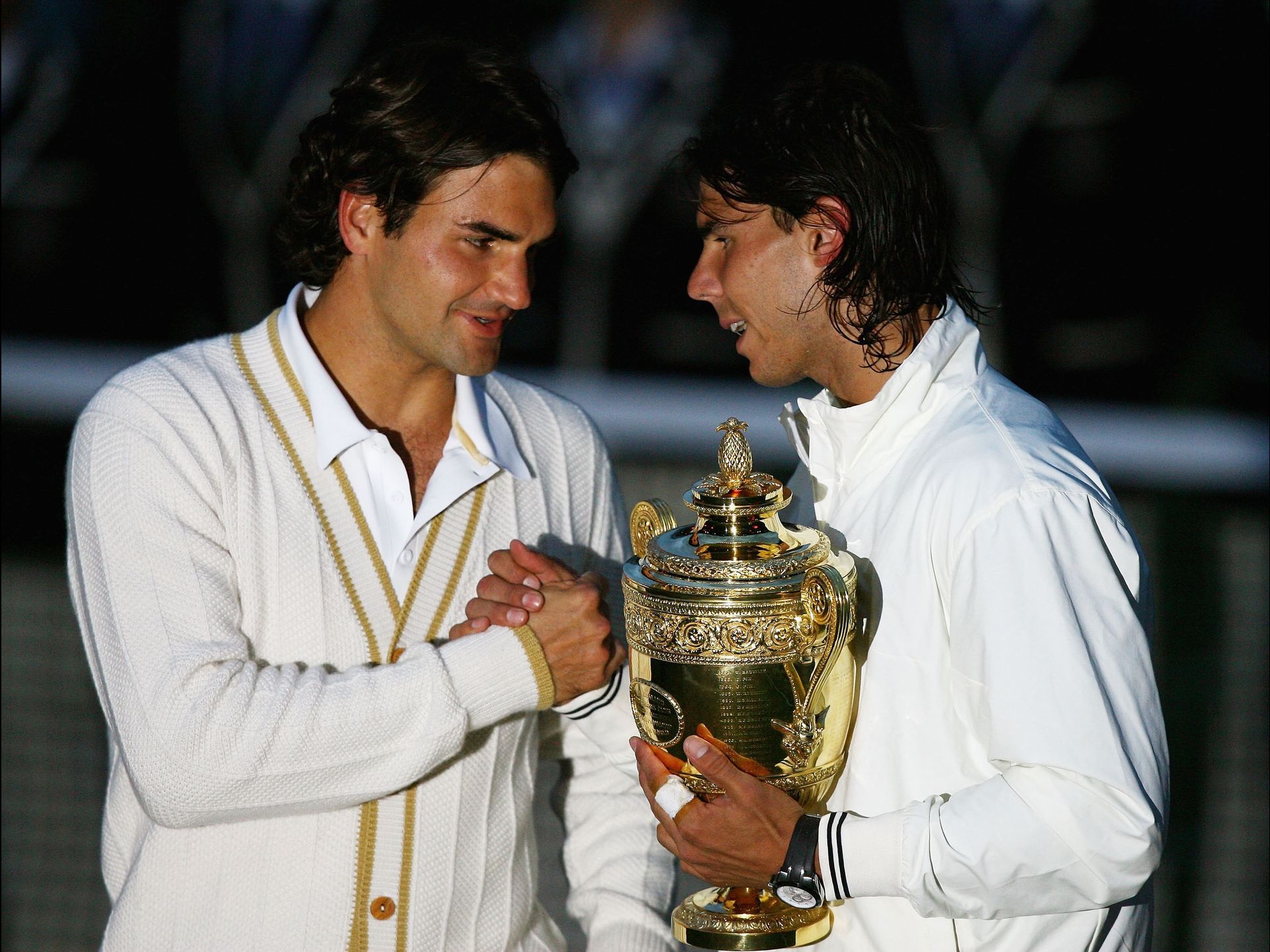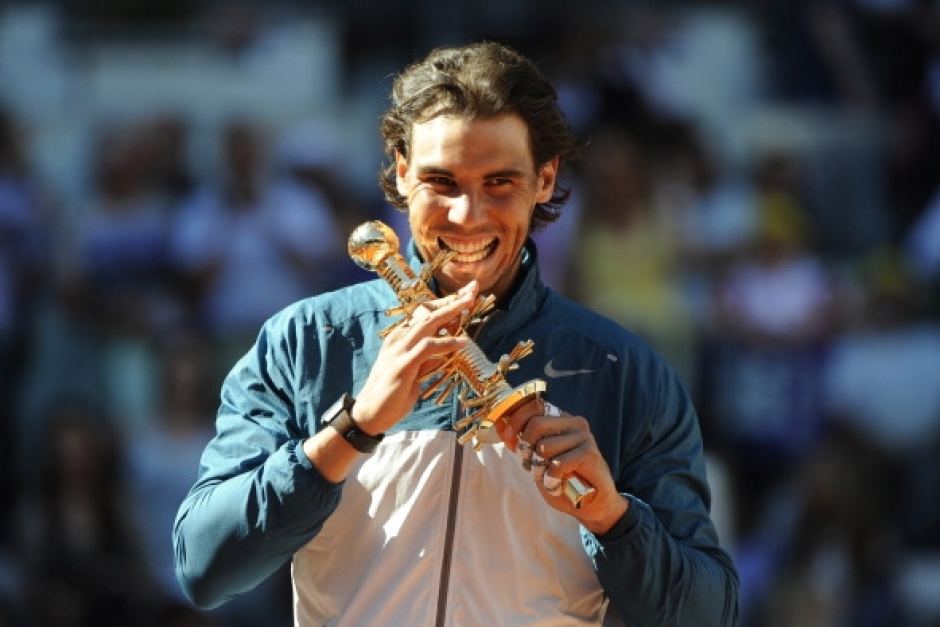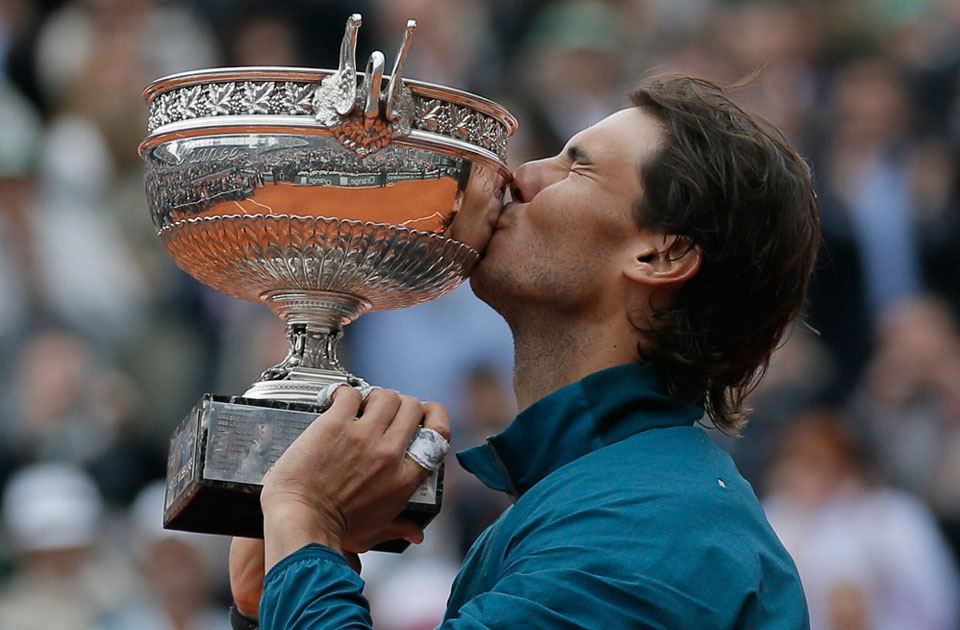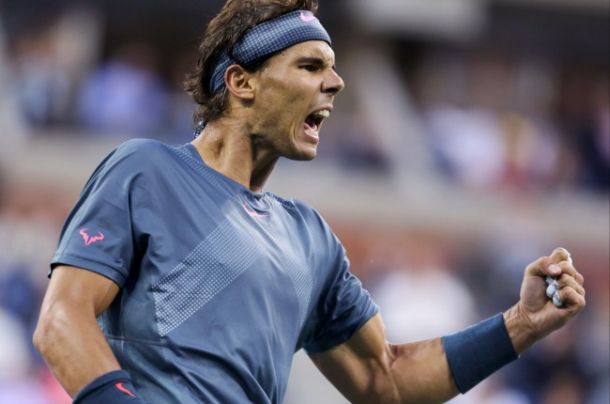Roger Federer is widely regarded as the greatest of all time (GOAT), but many wonder, and continue to contemplate, how Federer can be regarded as the best player of all time, when he is not conclusively the best player of his time. In this article, we delve into what makes Rafael Nadal the champion that he is, and why his case for the greatest is actually more convincing than it first appears...
Grand Slams/Olympics
Rafael Nadal has the second most, along with Pete Sampras, amount of Grand Slams to his name, with his tally at 14. That includes nine titles at the French Open (the most titles ever at one Grand Slam), two US Open's, two Wimbledon's and one Australian Open title. The Spaniard is the only man in history to have won at least one Grand Slam every year for the past decade. His trophy cabinet is one of the most impressive in sport, but perhaps the most phenomenal aspect of his Grand Slam success, is the way in which he won them. Nadal has been winning his Grand Slams in the most competitive era in tennis history. Every victory of his has been won the hard way, as he’s had to defeat the toughest opposition you can get in tennis, beating the likes of Djokovic and Federer.
When you compare Nadal’s Grand Slam matches compared to Federer’s, the debate gets a lot more interesting. The Swiss is 17-9 in Grand Slam finals, and he won his first 7 finals without playing Nadal. He beat players including Marat Safin, Marcos Baghdatis and Fernando González to win his first seven Majors. Albeit none of them were pushovers, Safin was the best of these three but still could not push Federer like Nadal has.
After beating Puerta to win his first Grand Slam at Roland Garros, Nadal had to play Federer in his next seven Grand Slam finals. With all due respect, it’s a lot easier to beat Baghdatis than it is Federer in a Grand Slam final. So despite Federer having more slams to his name, he had a much easier time winning them, even during his prime. The Spaniard had to endure blood, sweat and tears (literally) to win his Grand Slams against far tougher opposition.

The Spaniard is the only player in the Open Era to win 3 consecutive Grand Slams on 3 different surfaces: clay, hard and grass. The most impressive statistic of them all however, is that Nadal was the youngest player in the Open Era to complete the career Grand Slam at the age of just 24. He achieved his Career Grand Slam far earlier than Federer, and Djokovic still hasn't completed his. He is also just one Australian Open title away from a double career Grand Slam.
What’s even more mind-blowing though, is that Nadal has won slam after slam, despite his extensive list of infamous injuries. The Spaniard has been forced to miss seven Grand Slams since 2004. We’ll never know what results he might have achieved if he had played, but considering that he had to withdraw when he was at his prime, it’s likely he would have even more majors to his name. To summarize, even though Federer has won more Grand Slams, Rafa has had a much harder road to winning all of his. In the words of Andre Aggasi, who too, picks Nadal as the greatest of all-time, "Nadal had to deal with Federer, Djokovic, Murray in the golden age of tennis. He has done what he has done and he's not done yet."
Nadal also won a gold medal for winning the singles event at the Beijing Olympics in 2008, something that neither Djokovic nor Federer have, despite them playing in more Olympics than the Spaniard. Yet, that achievement isn’t brought up as much as it is deserved to be. Why does the number of Grand Slams have to be more important than everything else in the GOAT debate? The Olympics, the Davis Cup and Masters titles, (three aspects that Nadal leads) all should be deciding factors as they are a huge part of the sport.
Masters/World Tour Finals
The Spaniard holds the record for the most Masters 1000 titles, standing at an impressive 27. He also holds the record for the most finals (41) and semifinals (55). Just like his Grand Slam record, he’s the only player to win at least one Masters title for 10 consecutive years. His titles don’t just come on clay either; he’s won multiple titles on hard courts. If you treat Masters titles with the gravitas that they deserve, considering it’s basically just a condensed Grand Slam, (the same world-class opposition, but played in half the time), you could argue that Federer’s Grand Slam lead and Nadal’s Masters lead put them on equal terms.

Rafa has played in six World Tour Finals events, and has reached the final twice, being beaten by Federer in 2010 and Djokovic in 2013. It’s the one main title he is yet to win, given that indoor hard-court is probably his worst surface. Nadal has actually missed 4 of the last 10 ATP Finals due to injury, so it’s true that he has had less opportunity to win the Championship than the rest of the top players. Nonetheless, it's the main gap in his trophy cabinet at the moment.
Best Year
Nadal’s best year in his career was 2013, (closely followed by 2010) not just because of the amount of titles he won, but because it was the comeback year after a seven-month absence due to a career threatening knee injury. The Spaniard won 10 tournaments in 2013, including his 8th French Open title and 2nd US Open. His win-loss stood at 75-7, giving him a 91.46% winning record. Those results would be remarkable for any player, but what makes them even more mind-blowing is when one considers what he had to overcome to achieve them.
After a shock 2nd round loss at Wimbledon to Lukas Rosol, Nadal didn’t play another match for 7 months, citing tendonitis in the left knee as the problem. One-by-one, the Spaniard withdrew from all remaining tournaments in 2012 through to the start of 2013, including the London Olympics, the Australian Open and US Open, stating that he only wanted to compete again when he did not feel any pain.
His comeback begun on the 5th of February at the Chile Open, where he reached the final in both singles and doubles. Nadal then went on to win the Brasil Open and Mexico Open in Acapulco, beating Nalbandian and Ferrer to win back-to-back titles. From then on, things only got better for Nadal. In his first Masters event of his comeback year, Indian Wells, he beat Roger Federer in straight sets in the semifinal and Del Potro in the final, winning his 3rd title in the desert. The title proved to himself that he could play, and defeat, the top players once again.
As the clay season rolled around again, Rafa reached his ninth straight final in Monte Carlo, but lost to Djokovic. From that moment on, he didn’t lose another match on clay that year. He won in Barcelona, Madrid and Rome, defeating three top 6 players in a row. The ‘King of Clay’ then capped off his streak, winning an unprecedented 8th French Open. He won an epic semifinal against Novak Djokovic, 9-7 in the fifth, to reach the final, where he then defeated David Ferrer in straight sets.

The grass-court season was short for Rafa, as he lost to Steve Darcis in the first round of Wimbledon. Grass is a surface that is incredibly tough on his knees, given the speed of the surface and the low bounce. Many speculated that it was the end of the year for Rafa as he appeared visibly uncomfortable in the match, but he defied the odds once again, and carried on in a remarkable fashion. He won both the Montreal and Cincinnati Masters, and then went on to reach the final of the US Open. He was to face Novak Djokovic once again, in their 6th meeting in a major final. The match was epic, as Nadal came through in four sets to claim his 2nd US Open title and 13th Major overall.
Rafa reached the final of the China Open and the semifinal of the Shanghai Masters, where he lost to Novak Djokovic and Del Potro. Then, in the last part of the season, the indoor hard courts, typically Nadal’s worst surface, he had a good run, reaching the semifinal of the Paris Masters and the final of the ATP World Tour Finals. In London, he defeated Ferrer, Wawrinka, Berdych and Federer, only to lose to Djokovic in the final. Nonetheless, Rafa reclaimed his number one spot in the world. Not only was he back to his best, but he was the best once again.
The results of his 2013 season are phenomenal, but the emotion and mentality behind them are what makes them even more impressive. Many believed that Rafa’s career was over, or that he would never play at his best again. The way he came back to the tour in 2013, mentally relentless and motivated was something nobody expected, which is what makes it so remarkable.
Dominance at tournament(s)
Roland Garros is the tournament that first comes to mind when one discusses Rafa’s dominance. He’s won the French Open 9 times, the most wins at one Grand Slam in history. His lifetime record in Paris is 70-2, but what makes his dominance even more outrageous is his career record of best-of-five-set matches on clay. 94-2. Yes, you read that right, Rafa’s won nearly one hundred matches on the dirt, and only lost two. He practically owns every clay court tournament out there, he’s that good. His brilliance extends to other tournaments, including the Monte Carlo Masters, which he has won 8 times, (consecutively, this writer should add.) He’s won the Rome Masters seven times, and the Barcelona Open eight times, too.
Nadal is undoubtedly the most dominant player on one surface in history, and what’s more, he’s done it on the most demanding surface there is- clay. Known as the ‘King of Clay’, there’s nobody that deserves that accolade as much as Rafa Nadal.
It’s important to add though, that Rafa is not just dominant on clay. He was once regarded as just a clay-court specialist, which he still is, but there’s a lot more to him now. As stated earlier, Nadal is the only player in the Open Era to win 3 consecutive Grand Slams on 3 different surfaces. Some may not consider Rafa as the most consistent player given his mediocre last couple of years, but actually, he holds countless records due to his consistency. He stands alone as the player to win at least one Grand Slam, Masters and ATP 500 Series title for the last ten years.
Head-to-Head
Head to head records are hugely important in tennis, and they tell us a lot about a player’s dominance over another. Nadal has a winning record against all of the top players in his era. Just think about that. He’s dominant over all of them, and this writer is talking Murray, Djokovic and Federer. Sure, one could argue that there are many players that also have winning records over Rafa, so the head-to-heads don’t tell us anything, but when players compete against each other 30+ times, it’s a whole different story.
Nadal’s head to head records against the rest of the ‘Big Four’
Federer 23-10 69.7%
Djokovic 23-21 52.27%
Murray 15-6 71.43%
The Swiss is tennis’ presumptive GOAT, but his record - his rival contender for the greatest, Nadal, is certainly something to keep in mind. Of course, a head to head does not tell us everything, but it does give us a fascinating insight. Consider this- Nadal has beaten Federer in 9 of their 11 meetings in majors. So, how can a player like Federer be the definitive greatest of all-time, when there’s one man that has such a dominant and decisive record over him?
Mentality
One of the things that defines a champion, or in this case, the greatest of all time, is a player's mentality and attitude. Rafa is known for having one of the strongest mentalities in all of sport, and it's something that makes him stand out from the other top players. Nadal's mentality is one of the most- if not the most- vital ingredient to his success over the years.
He's fierce, relentless, passionate and powerful, playing every point like it is his last. His fighting attitude is not only admired by millions, but it's the extra spark that makes him the champion that he is. Rafa never gives up, ever. He'll believe he can win a match until the very last point, even if his hopes of turning things around are so incredibly slim. Nadal plays like he has something to prove, and always comes into a tournament thinking like he is the underdog. The Spaniard is respected as one of the most hard-working players on tour. He is always finding solutions, working to improve every aspect of his game.
Many wonder how Rafa comes back from injuries so remarkably, in particular, his 2013 comeback year. His mind is what fueled him to return to his best, he has incredible discipline on and off the court. Many players struggle to recover from injuries due to not only the physical drawbacks, but the mental drawbacks, however Rafa has always worked through them. He is realistic but always positive. That, paired with his willingness and passion for the game, are the key reasons why he works as hard as possible to recover in the way that he does.
Rafa's had to endure countless injuries throughout his career. His first and potentially most serious issue came a decade ago in 2005, where he damaged his tarsal scaphoid bone in his foot. Rafa's doctor said that he wouldn't be able to play tennis again, but he found a way to pursue his dreams, having specially made soles created for his shoes.
The most heartbreaking moment of his career came last year in the final of the Australian Open, where a back injury he sustained during the warm-up hampered his game. Rafa could barely play a point without doubling over, but he battled through his injury, not wanting to disappoint the fans and the crowd. "You learn more about a champion when he's flat on his back and in defeat than you do in victory.", said Craig Tiley after the courageous effort Rafa displayed. Just a few months later, Rafa won Roland Garros. It was a slow and long road to his recovery of his back and most importantly, confidence, (which is still not back even today) but he did everything he could to be competitive again. After all the suffering, he finally had something to celebrate. "Today gave me back what happened in Australia." explained the Spaniard. Nadal finds a way to overcome adversity, always.
If you watch any of Rafa's tighter matches, you'll see his fighting spirit in action. He plays intensely at all times, and works his way back into matches, treating every point like it is match point. He gets himself fired up by shouting 'vamos!', (meaning 'let's go!' in Spanish) to himself while pumping his fists. It's an example of his passion seeping through his game, while still being the respectful man that he is. You'll never see him smash a racket and will rarely see him argue with an umpire.
Nadal's attitude and mental strength not only make him a fantastic role model, but make him a champion. Tennis is a mental battle as well as a physical battle, which is why mentality is such an important factor in the debate for the greatest of all time. If you could choose one player to play a match for you because your life depended on it, Rafa Nadal would be the man to call, there's no doubt about it.
Rafael Nadal has achieved more than most would dare to dream of in his elustrous career, and it's not over yet. The numbers speak for themselves, but his unrelenting passion and determination make him the champion that he is today, and his humility off-court makes him one of the most respected athletes in the world. Rafa is often overlooked in the debate for the greatest of all time, but when you dig a little deeper, you uncover just how remarkable his career really is. He's fought for every victory in the toughest era in tennis, and he's overcome the largest of hurdles. Rafael Nadal appears almost superhuman, but the most wonderful thing, is that he's as human as champions come.






































